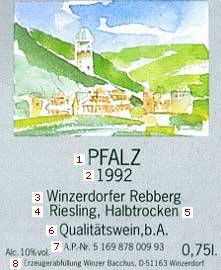|
Bartenders Guide: Deciphering German Wine LabelsGerman is just not a fun language for me. When pronounced correctly, I feel like I'm about to cough up a furball. Of course, when it's spoken by a statuesque Frau, it sounds a little better. German wine used to be renowned for its quality, but years of war and division eventually took their toll until it became synonymous with the overly-sweet, mass-produced Liebfraumilch. (pronounced: leeb-frow-milk) In recent years, however, Germany is making a strong comeback. Some of the finest white wines in the world are produced from grapes grown along the Rhine and Mosel rivers. German Rieslings are the most notable and range from sweet, ambrosia-like nectars to spicy, crisp wines that are a fantastic accompaniment to your next dinner party, depending upon the growing region and when the grapes are harvested, which affects their sugar content. German reds are a different story. Although the country's predominant red grape is the Pinot Noir, (called Spätburgunder, domestically), the variable German climate does odd and occasionally unpleasant things to this now-familiar varietal. The long, cool growing season often results in a thin, pale and acidic wine, very different from the vibrant and robust California, Oregon and French Pinots that most of us know and enjoy. I don't want to force my opinions on anybody...there may in fact be delicious German reds I haven't tried, yet...but until I chance upon them, I'm sticking with the whites. If you look below, you'll see the basic anatomy of a German Wine Label, along with a mini-glossary of some more common terms. It is blatantly copied from other sources, but since it's available in so many places, I've no idea whom to credit. In any event, I'm not here to reinvent the wheel...I'm here to put useful information in one place for you. - Frost 
2. Vintage 3. Village and vineyard 4. Varietal Grape 5. Level of Dryness Trocken indicates a dry wine without perceptible residual sweetness. It never contains more than 9 grams of residual sugar per liter and often less. This is very dry and would be my style of choice for pairing with a meal. 7. AP Number
5 stands for the testing center, where the wine was approved 8. Producer or Bottler There are about 100,000 grape growers in Germany, yet only about one fourth as many wine producers. If the label indicates "Erzeugerabfüllung" (estate bottled), it assures you that the grapes were grown and the wine was produced by the same grower or cooperative of growers, called "Winzergenossenschaft". As an alternative to "Erzeugerabfüllung," estates and growers which grow, produce, and bottle their own wine can use the term "Gutsabfüllung" on the label. The grower or collective group of growers is responsible for and guarantees the quality of the wine. Sometimes the bottlers or shipper will assume responsibility and will be identified on the label as "Abfüller". Quick glossary of German Wine Terms: Spätlese (pronounced schpayt-laze-ah): this literally means late-pick and is the second and riper harvest. These wines will have riper fruit flavors but should still maintain a strong acidity. Auslese (pronounced ows-laze-ah): this literally means out-pick. Auslese wines are the ripest clusters from a late harvest. These grapes are selected to be vinified and bottled separately. Auslese wines are meant to represent the cream of the crop. Trocken (pronounced troh-kin): indicates a fully dry wine. Feinherb (pronounced fine-erb): a relatively new descriptor indicating a drier-style wine. Dessert (fully sweet) wine designations: Beerenauslese (pronounced bear-in-ows-laze-ah): very ripe selected berries. Trockenbeerenauslese (pronounced troh-kin bear-in-ows-laze-ah): extremely ripe, dried, selected berries. Eiswein (pronounced eyes-vine): frozen berries with ripe, concentrated juice.
|





